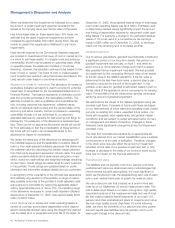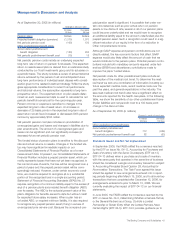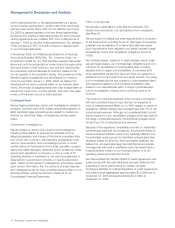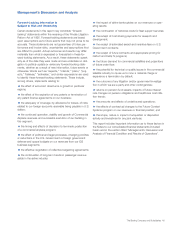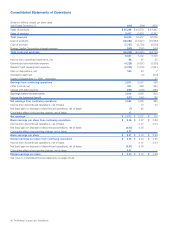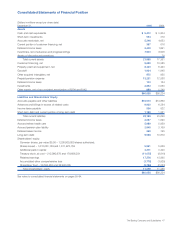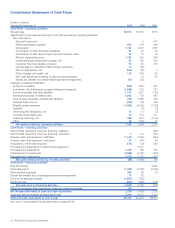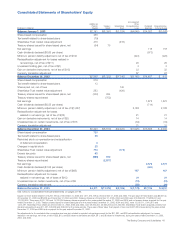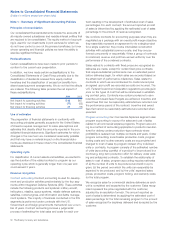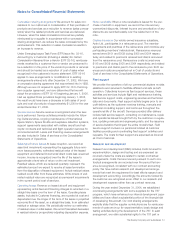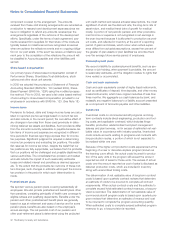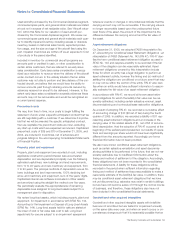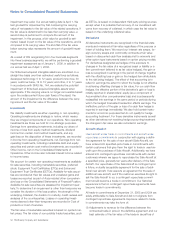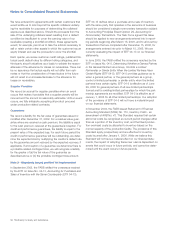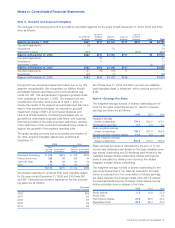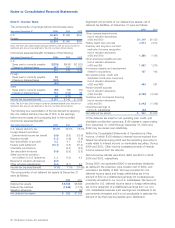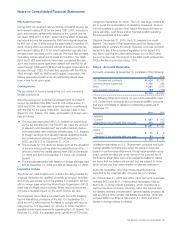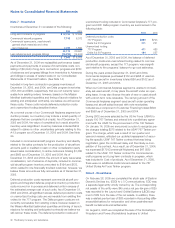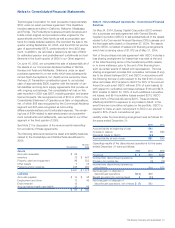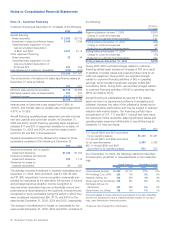Boeing 2005 Annual Report Download - page 54
Download and view the complete annual report
Please find page 54 of the 2005 Boeing annual report below. You can navigate through the pages in the report by either clicking on the pages listed below, or by using the keyword search tool below to find specific information within the annual report.Notes to Consolidated Financial Statements
component covered by the arrangement. The amounts
received from these cost sharing arrangements are recorded as
a reduction to research and development expenses since we
have no obligation to refund any amounts received per the
arrangements regardless of the outcome of the development
efforts. Specifically, under the terms of each agreement, pay-
ments received from suppliers for their share of the costs are
typically based on milestones and are recognized as earned
when we achieve the milestone events and no ongoing obliga-
tion on our part exists. In the event we receive a milestone pay-
ment prior to the completion of the milestone the amount will
be classified in Accounts payable and other liabilities until
earned.
Share-based compensation
Our primary types of share-based compensation consist of
Performance Shares, ShareValue Trust distributions, stock
options and other stock unit awards.
In 2005 we adopted the provisions of Statement of Financial
Accounting Standard (SFAS) No. 123 (revised 2004), Share-
Based Payment (SFAS No. 123R) using the modified prospec-
tive method. Prior to 2005, we used a fair value based method
of accounting for share-based compensation provided to our
employees in accordance with SFAS No. 123. (See Note 18.)
Income taxes
Provisions for federal, state and foreign income taxes are calcu-
lated on reported pre-tax earnings based on current tax law
and also include, in the current period, the cumulative effect of
any changes in tax rates from those used previously in deter-
mining deferred tax assets and liabilities. Such provisions differ
from the amounts currently receivable or payable because cer-
tain items of income and expense are recognized in different
time periods for financial reporting purposes than for income
tax purposes. Significant judgment is required in determining
income tax provisions and evaluating tax positions. We estab-
lish reserves for income tax when, despite the belief that our
tax positions are fully supportable, we believe that it is probable
that our positions will be challenged and possibly disallowed by
various authorities. The consolidated tax provision and related
accruals include the impact of such reasonably estimable
losses and related interest and penalties as deemed appropri-
ate. To the extent that the probable tax outcome of these mat-
ters changes, such changes in estimate will impact the income
tax provision in the period in which such determination is
made.
Postretirement plans
We sponsor various pension plans covering substantially all
employees. We also provide postretirement benefit plans other
than pensions, consisting principally of health care coverage to
eligible retirees and qualifying dependents. Benefits under the
pension and other postretirement benefit plans are generally
based on age at retirement and years of service and for some
pension plans, benefits are also based on the employee’s
annual earnings. The net periodic cost of our pension and
other post-retirement plans is determined using the projected
unit credit method and several actuarial assumptions, the most
significant of which are the discount rate, the long-term rate of
asset return, and medical trend (rate of growth for medical
costs). A portion of net periodic pension and other post-retire-
ment income or expense is not recognized in net earnings in
the year incurred because it is allocated to production as prod-
uct costs, and reflected in inventory at the end of a reporting
period. If gains and losses, which occur when actual experi-
ence differs from actuarial assumptions, exceed ten percent of
the greater of plan assets or plan liabilities we amortize them
over the average future service period of employees.
Postemployment plans
We record a liability for postemployment benefits, such as sev-
erance or job training, when payment is probable, the amount
is reasonably estimable, and the obligation relates to rights that
have vested or accumulated.
Cash and cash equivalents
Cash and cash equivalents consist of highly liquid instruments,
such as certificates of deposit, time deposits, and other money
market instruments, which have original maturities of less than
three months. We aggregate our cash balances by bank, and
reclassify any negative balances to a liability account presented
as a component of Accounts payable and other liabilities.
Inventories
Inventoried costs on commercial aircraft programs and long-
term contracts include direct engineering, production and tool-
ing costs, and applicable overhead, which includes fringe
benefits, production related indirect and plant management
salaries and plant services, not in excess of estimated net real-
izable value. In accordance with industry practice, inventoried
costs include amounts relating to programs and contracts with
long production cycles, a portion of which is not expected to
be realized within one year.
Because of the higher unit production costs experienced at the
beginning of a new or derivative airplane program (known as
the learning curve effect), the actual costs incurred for produc-
tion of the early units in the program will exceed the amount
reported as cost of sales for those units. The excess of actual
costs over the amount reported as cost of sales is disclosed as
deferred production costs, which are included in inventory
along with unamortized tooling costs.
The determination of net realizable value of long-term contract
costs is based upon quarterly contract reviews that determine
an estimate of costs to be incurred to complete all contract
requirements. When actual contract costs and the estimate to
complete exceed total estimated contract revenues, a loss pro-
vision is recorded. The determination of net realizable value of
commercial aircraft program costs is based upon quarterly pro-
gram reviews that determine an estimate of revenue and cost
to be incurred to complete the program accounting quantity.
When estimated costs to complete exceed estimated program
revenues to go, a loss provision is recorded.
52 The Boeing Company and Subsidiaries


